In a world driven by ever-advancing technology, the demand for seamless and efficient power and data transmission has never been greater. From complex machinery to cutting-edge robotics, industries rely on uninterrupted connectivity to push the boundaries of innovation. Enter the flat disc electrical slip ring, a groundbreaking technology set to revolutionize the way we establish connections across rotating interfaces. Discover the remarkable potential of flat disc electrical slip rings and how they are reshaping industries with their futuristic design.
One key advantage of flat disc electrical slip rings is their potential for customization. Engineers can tailor these connectors to meet the specific requirements of different applications, including the number of rings, signal types, and even integration of other features such as fluid transmission. This flexibility enables seamless integration into a wide range of systems, further expanding the possibilities for innovation and efficiency.
As the demand for compact and versatile slip ring solutions continues to grow, ongoing research and development are focused on enhancing the capabilities of flat disc electrical slip rings.
Efforts are being made to improve materials, reduce friction, and optimize performance for long-term reliability. With each advancement, the potential applications of flat disc slip rings expand, transforming industries and pushing the boundaries of what is possible.
In conclusion, the advent of flat disc electrical slip rings marks a significant milestone in the pursuit of seamless connectivity. With their compact design and remarkable capabilities, these connectors are reshaping industries such as robotics, aerospace, and renewable energy. As ongoing advancements drive the evolution of flat disc slip rings, we can expect to witness even greater integration, efficiency, and innovation across various sectors. Prepare to be amazed as the future unfolds with flat disc electrical slip rings at the forefront of technological progress.
What Is Flat Disc Electrical Slip Ring
A flat disc electrical slip ring is a type of slip ring specifically designed for transmitting electrical signals and power between rotating and stationary parts of a machine or system. Unlike traditional cylindrical slip rings, flat disc slip rings have a disc-like shape, which can be more suitable for applications where space is constrained or where a low-profile design is required.
The flat disc electrical slip ring represents a significant leap forward in the realm of rotary electrical connectors. These innovative devices are designed to transmit electrical currents and data signals while allowing for continuous rotation, all within a flat, disc-like structure. By eliminating the bulkiness and limitations of traditional slip rings, the flat disc design opens up new possibilities for seamless connectivity across a wide range of applications.
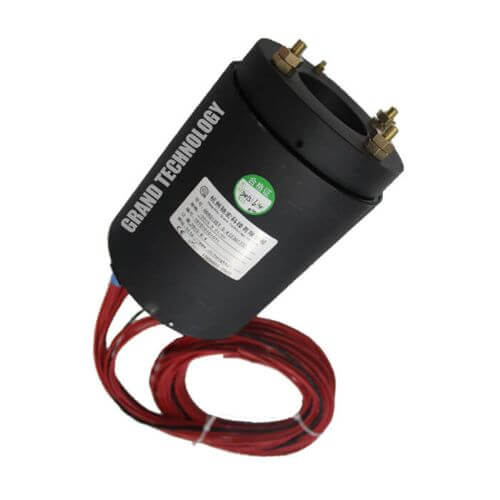
Traditionally, slip rings were cylindrical in shape, presenting challenges in terms of space constraints and integration into compact systems. However, with the advent of flat disc electrical slip rings, engineers and innovators can now overcome these limitations, unlocking a world of opportunities in various industries.
At the core of flat disc electrical slip rings lies a technologically advanced architecture. The compact design incorporates a series of conductive rings and brushes within the flat disc structure, ensuring consistent contact and reliable transmission of power and data signals. This breakthrough technology enables seamless rotation while maintaining uninterrupted connectivity, revolutionizing the way rotating systems operate.
Structure of Flat Disc Electrical Slip Ring
The structure of a flat disc electrical slip ring is designed to facilitate the transmission of electrical signals or power from a stationary part to a rotating part through a compact, low-profile form factor. Here’s a breakdown of the main components and how they are typically arranged:
1. Base/Disc Plate:
- The foundation of the slip ring is a flat, circular plate, often made from an insulating material like plastic, ceramic, or composite materials. This base provides structural support for the entire assembly.
2. Concentric Rings (Conductive Tracks):
- On the surface of the disc, there are one or more concentric conductive rings (tracks). These rings are typically made from materials like copper, silver, or gold, depending on the application’s requirements for conductivity and wear resistance.
- Each ring corresponds to a separate electrical channel, allowing multiple signals or power lines to be transmitted simultaneously.
3. Brushes/Contact Pads:
- The brushes, or contact pads, are part of the rotating assembly and are typically spring-loaded to maintain constant contact with the conductive rings.
- These brushes are usually made from conductive materials like graphite, copper, or precious metal alloys. They slide over the concentric rings as the disc rotates, allowing for continuous electrical contact.
4. Rotating Shaft or Hub:
- The brushes are often mounted on a rotating shaft or hub that is connected to the rotating part of the machine or system.
- This hub is aligned with the center of the disc, allowing for smooth rotation while maintaining electrical contact.
5. Insulating Layer:
- An insulating layer is often placed between the conductive rings to prevent short-circuiting and ensure that each ring is electrically isolated from the others.
6. Housing/Cover:
- The entire assembly may be enclosed in a protective housing or cover, which shields the internal components from dust, debris, and environmental factors.
- The housing also helps to maintain the alignment of the brushes and rings, ensuring reliable operation.
7. Wiring/Terminals:
- Wires or terminals are connected to the conductive rings on the stationary part of the slip ring, allowing external electrical connections to be made.
- Similarly, wires connected to the brushes transmit the electrical signals or power to the rotating part of the system.
8. Bearings (Optional):
- Some flat disc slip rings incorporate bearings to reduce friction and wear between the rotating and stationary components. These bearings are usually positioned between the rotating hub and the stationary disc plate.
Operational Flow
- As the rotating part of the system moves, the brushes slide over the concentric rings, maintaining continuous electrical contact.
- The signals or power flow from the stationary wires through the conductive rings, into the brushes, and finally to the rotating part of the system.
Design Variations
- The specific design of flat disc slip rings can vary depending on the application. For example, some designs may have multiple layers of discs to increase the number of channels without increasing the diameter of the slip ring.
This structure allows flat disc electrical slip rings to be compact, reliable, and suitable for applications where traditional slip rings might not fit or be as effective.

Unique Design Exclusive to Flat Disc Electrical Slip Ring
The flat disc electrical slip ring has several unique design features that differentiate it from traditional cylindrical slip rings. These features make it particularly suitable for certain applications where space constraints, low-profile requirements, or specific operational needs are critical. Here are the unique design elements exclusive to flat disc electrical slip rings:
1. Low-Profile, Compact Design:
- The most defining characteristic of a flat disc slip ring is its slim, disc-like shape. This low-profile design allows the slip ring to be used in applications where vertical space is limited, such as in compact devices or systems with restricted height clearances.
- Unlike cylindrical slip rings, which have a taller structure due to their drum-like shape, flat disc slip rings are designed to spread out horizontally, making them ideal for integrating into flat or shallow enclosures.
2. Concentric Ring Configuration:
- The electrical pathways in a flat disc slip ring are arranged as concentric rings on a flat surface. This arrangement differs from the axial alignment of conductive paths found in cylindrical slip rings.
- The concentric ring configuration is not only space-efficient but also allows for easy scalability. Additional rings can be added concentrically to increase the number of channels without significantly increasing the overall thickness of the slip ring.
3. Radial Brush Movement:
- In a flat disc slip ring, the brushes or contact pads typically move radially across the concentric rings as the disc rotates. This radial movement is distinct from the linear or rotational movement of brushes in cylindrical designs.
- The radial brush movement in a flat disc design ensures consistent contact with the rings, minimizing wear and tear while maintaining reliable electrical connectivity.
4. Customizable Ring and Brush Configuration:
- The flat disc design allows for greater flexibility in customizing the number and arrangement of rings and brushes. The spacing, width, and material of the rings can be tailored to suit specific electrical requirements, such as varying voltage or current levels.
- This customization can include the use of different materials for the rings to optimize conductivity, reduce noise, or enhance durability, depending on the application’s demands.
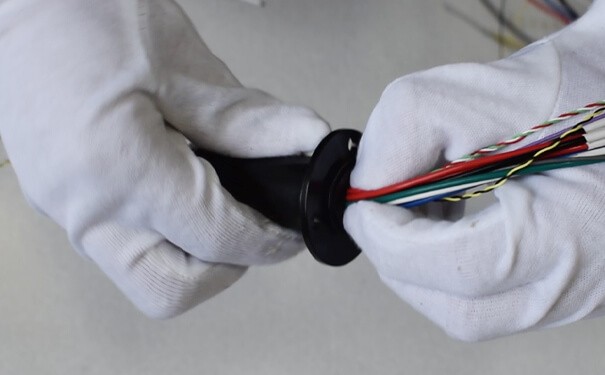
5. 360-Degree Rotation with Minimal Height:
- Flat disc slip rings can achieve full 360-degree rotation while maintaining a minimal height profile. This is particularly beneficial in applications like rotating displays, medical devices, or compact robotic systems, where both continuous rotation and minimal space usage are crucial.
- The minimal height of the flat disc design also contributes to reduced overall system weight, which can be a significant advantage in mobile or airborne applications.
6. Simplified Mounting and Integration:
- The flat design allows for easier mounting and integration into various systems, especially where the slip ring needs to be embedded within a flat surface or attached to a rotating platform.
- The flat surface of the disc can often be directly mounted onto a rotating shaft or platform, simplifying the mechanical design and reducing the need for additional mounting components.
7. Multi-Layered Disc Stacks (in Advanced Designs):
- Some advanced flat disc slip rings incorporate multiple stacked discs, each with its own set of concentric rings. This multi-layer design allows for a greater number of channels without increasing the horizontal footprint.
- These stacked designs are particularly useful in complex systems requiring numerous electrical connections within a compact space.
8. Optimized for Low-Speed or Intermittent Rotation:
- While flat disc slip rings can be used in various rotational speed, they are particularly well-suited for low-speed or intermittent rotation applications. The flat disc structure provides stable and reliable electrical contact even at slower speeds or when the rotation is not continuous.
- This feature makes them ideal for applications like indexing tables, certain types of rotary sensors, and other systems where rotation may be incremental or sporadic.
These unique design aspects of flat disc electrical slip rings make them an optimal choice for specialized applications that require a compact, low-profile solution with the flexibility to handle various electrical signals and power transmission needs.
Advantages and Disadvantages of Flat Disc Electrical Slip Ring
Advantages of Flat Disc Electrical Slip Rings:
- Compact and Low-Profile Design:
- Advantage: The flat, disc-like structure makes these slip rings ideal for applications where space is limited, particularly in terms of height. This design allows them to be easily integrated into systems where a traditional cylindrical slip ring would be too bulky.
- Scalability and Customization:
- Advantage: The concentric ring arrangement allows for easy customization of the number of channels. Additional rings can be added concentrically without significantly increasing the slip ring’s overall thickness, making it adaptable to various signal and power transmission requirements.
- Reduced Weight:
- Advantage: The flat design generally results in a lighter overall component compared to cylindrical slip rings, which can be beneficial in applications where weight is a critical factor, such as in drones, mobile devices, or aerospace components.
- Ease of Mounting:
- Advantage: The flat surface of the disc can be easily mounted onto a rotating platform or embedded within a flat surface, simplifying the integration process and reducing the need for additional mounting components.
- Lower Friction and Wear:
- Advantage: The radial movement of brushes across the concentric rings often results in lower friction compared to the axial contact in cylindrical designs, potentially leading to less wear and longer service life, especially in low-speed applications.
- Versatility in Applications:
- Advantage: Due to their low-profile nature, flat disc slip rings are versatile and can be used in a wide range of applications, including medical devices, robotics, rotary sensors, and compact rotating displays.
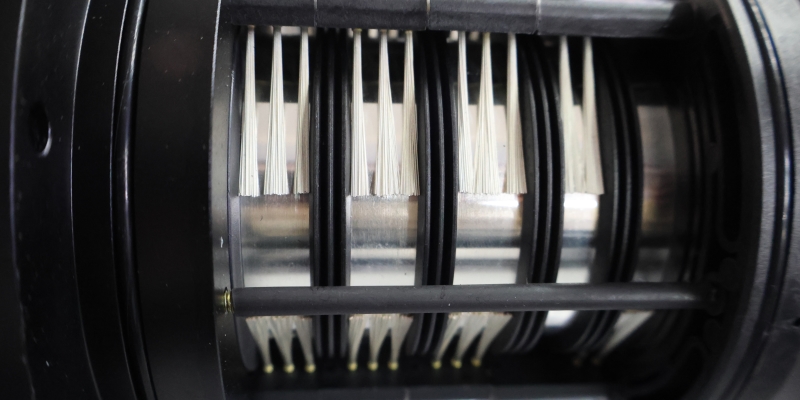
Disadvantages of Flat Disc Electrical Slip Rings:
- Limited Current Capacity:
- Disadvantage: Flat disc slip rings typically have a lower current capacity compared to their cylindrical counterparts. The design constraints of the flat, thin rings mean they are less capable of handling high currents, which limits their use in power-intensive applications.
- Potential for Signal Interference:
- Disadvantage: The close proximity of concentric rings in a flat design can lead to electromagnetic interference (EMI) between adjacent channels, especially if not properly shielded or designed. This can affect the quality of signal transmission, particularly in sensitive applications.
- Wear and Tear:
- Disadvantage: Although flat disc slip rings can have lower friction, the radial movement of brushes can still cause wear over time, especially in applications with high rotational speeds or continuous operation. The flat design may also lead to uneven wear across the rings, potentially reducing the lifespan of the component.
- Complexity in Manufacturing:
- Disadvantage: The precision required to create the concentric rings and maintain consistent contact can make the manufacturing process more complex and potentially more expensive compared to cylindrical slip rings.
- Limited Speed Capabilities:
- Disadvantage: Flat disc slip rings are generally better suited for low-speed or intermittent rotation applications. At higher speeds, maintaining stable contact between the brushes and the rings can become challenging, leading to potential issues with signal integrity or increased wear.
- Thermal Management Challenges:
- Disadvantage: The compact, flat design can lead to challenges in dissipating heat, especially in applications with high power transmission or continuous operation. Poor thermal management can affect the performance and longevity of the slip ring.
- Complex Wiring:
- Disadvantage: The wiring and connections can be more complex due to the flat configuration, especially when multiple channels are involved. This can make the installation and maintenance process more challenging compared to simpler cylindrical designs.
While flat disc electrical slip rings offer significant advantages in terms of compactness, versatility, and ease of integration, they come with trade-offs such as limited current capacity, potential signal interference, and challenges in handling high-speed operations. They are best suited for specialized applications where their unique design features can be fully leveraged.
Need assistance with slip ring selection? Contact our experts by filling out the form.
Applications of Flat Disc Electrical Slip Ring
Flat disc electrical slip rings are well-suited for various applications where space constraints, low-profile requirements, or specific operational needs are critical. Here are some key applications:
1. Medical Devices
- Application: Used in medical imaging equipment such as CT scanners and MRI machines where precise and continuous rotation is required for the imaging components.
- Reason: The compact design allows for easy integration into devices with limited space, while ensuring reliable signal and power transmission during rotation.
2. Robotic Arms and Automation Systems
- Application: Implemented in robotic arms, especially in compact or specialized robots used in manufacturing, surgery, or precision tasks.
- Reason: The low-profile design minimizes the impact on the robot’s size and weight, enabling smooth rotational movement while transmitting control signals and power.

3. Rotary Tables and Indexing Systems
- Application: Used in rotary tables and indexing systems that require precise positioning and rotation, common in manufacturing, assembly, and testing equipment.
- Reason: The flat disc slip ring allows for continuous rotation without adding significant height, which is crucial for maintaining the system’s low profile.
4. Aerospace and Defense
- Application: Utilized in systems like antennas, radar systems, and satellite communication devices that require reliable rotation and data transmission.
- Reason: The lightweight and compact nature of flat disc slip rings is ideal for airborne systems where weight and space are critical factors.
5. Renewable Energy Systems
- Application: Found in wind turbines, particularly in smaller, compact designs where space and weight are limited.
- Reason: Flat disc slip rings can handle the necessary power and signal transmission in a space-efficient manner, making them suitable for the rotating components in these systems.
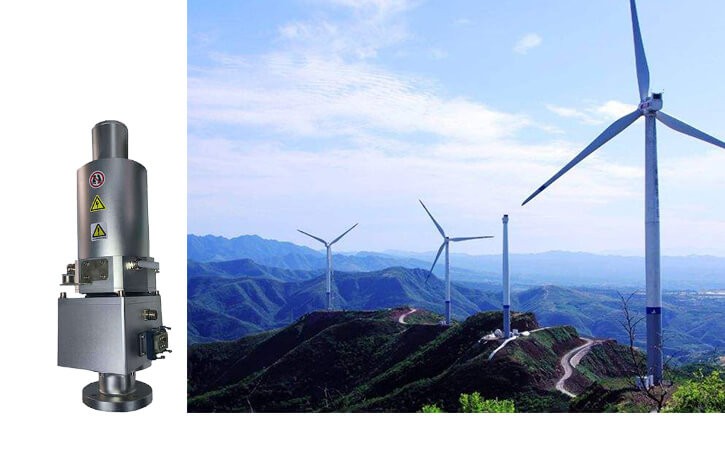
6. Turntables and Rotating Displays
- Application: Commonly used in rotating displays, exhibition stands, and turntables where continuous rotation and signal transmission are needed.
- Reason: The flat design ensures that the display or turntable remains aesthetically pleasing and functional without bulky components.
7. Compact Rotating Sensors
- Application: Employed in rotating sensors that need to transmit data continuously, such as in lidar systems used for autonomous vehicles or drones.
- Reason: The low-profile, lightweight design of flat disc slip rings is ideal for integrating into compact sensor systems that require full rotational movement.
8. Optical Equipment
- Application: Utilized in optical devices like rotating cameras, projectors, and microscopes where continuous rotation and signal transmission are critical.
- Reason: The compact nature of flat disc slip rings allows them to be integrated into optical systems without interfering with the optical paths or increasing the device’s size.
9. Telecommunication Equipment
- Application: Applied in rotating antennas and communication systems where stable signal transmission is needed during continuous rotation.
- Reason: The ability to transmit data and signals reliably while maintaining a low profile makes flat disc slip rings suitable for modern telecommunication systems.
10. Surveillance and Security Systems
- Application: Used in pan-tilt-zoom (PTZ) cameras and other surveillance equipment that require continuous rotation for monitoring large areas.
- Reason: The flat design allows these cameras to rotate smoothly without bulky components, ensuring uninterrupted power and data transmission.

11. Automotive and Electric Vehicles
- Application: Found in various automotive applications, including steering systems, in-wheel motors, or rotating infotainment displays.
- Reason: The compact size and ability to handle multiple signals make flat disc slip rings ideal for the evolving needs of automotive electronics.
12. Consumer Electronics
- Application: Incorporated into rotating components of consumer electronics such as smart speakers, rotating display screens, and interactive kiosks.
- Reason: The space-saving design fits well within the compact housing of consumer devices, ensuring smooth operation and longevity.
13. Industrial Machinery
- Application: Used in various industrial machinery requiring rotation, such as in packaging machines, printing presses, and textile machines.
- Reason: The ability to transmit signals and power without disrupting the machine’s operation is essential in maintaining high efficiency and precision.
These applications demonstrate the versatility of flat disc electrical slip rings in situations where traditional cylindrical slip rings might be impractical due to size, weight, or design constraints.
Product Variety of Flat Disc Electrical Slip Ring
Flat disc electrical slip rings come in various types and configurations to meet the specific needs of different applications. Here’s a breakdown of the product varieties available:
1. Basic Flat Disc Slip Rings
- Description: Standard models with a basic design, typically featuring a single layer of concentric rings for transmitting signals or low-power electrical currents.
- Applications: Suitable for general-purpose applications such as rotating displays, turntables, and low-power robotics.
- Features: Compact, low-profile, with a limited number of channels.
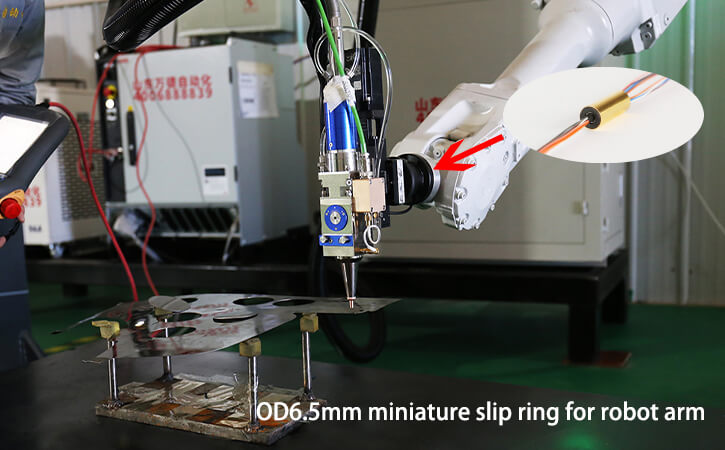
2. High-Current Flat Disc Slip Rings
- Description: Designed to handle higher current loads, these slip rings feature thicker conductive rings and robust brushes to accommodate higher power transmission.
- Applications: Used in applications like wind turbines, industrial machinery, and power transmission systems where higher current handling is required.
- Features: Enhanced current capacity, durable materials, and often a larger diameter to support the increased current flow.
3. Multi-Layer Flat Disc Slip Rings
- Description: These slip rings have multiple layers of discs stacked on top of each other, each with its own set of concentric rings, allowing for more channels within the same footprint.
- Applications: Ideal for complex systems requiring multiple signal or power channels, such as advanced medical equipment, multi-axis robotic arms, and aerospace systems.
- Features: Increased channel count without a significant increase in thickness, customizable configurations.
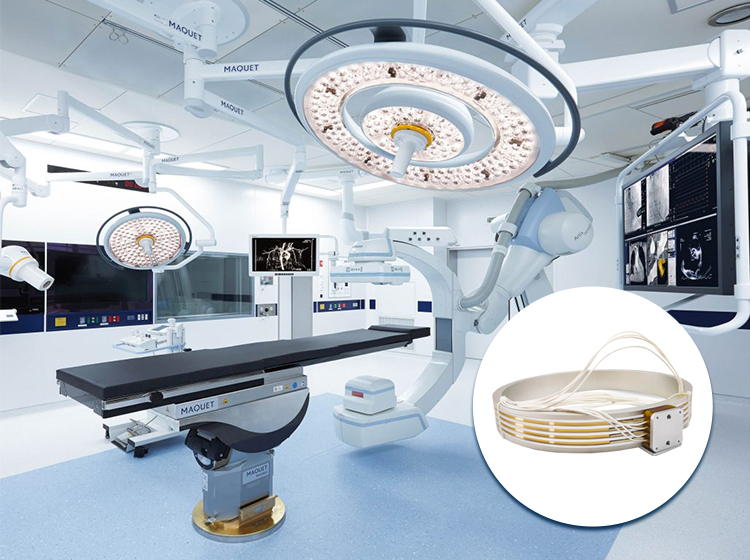
4. Miniature Flat Disc Slip Rings
- Description: Extremely small and compact slip rings designed for applications with very limited space.
- Applications: Used in miniature devices, such as small drones, compact sensors, and micro-robotics.
- Features: Ultra-compact design, low weight, typically with a limited number of channels.
5. High-Frequency Flat Disc Slip Rings
- Description: These slip rings are optimized for transmitting high-frequency signals with minimal interference, featuring advanced shielding and precise manufacturing.
- Applications: Suitable for telecommunications, radar systems, and high-speed data transmission in rotating equipment.
- Features: Shielded conductive paths, high precision, designed to minimize signal loss and electromagnetic interference.
6. Hybrid Flat Disc Slip Rings
- Description: Combines electrical channels with other transmission capabilities, such as fiber optics, fluid or gas channels, or high-frequency coaxial channels, within the same slip ring.
- Applications: Used in complex systems like medical devices, aerospace applications, and advanced robotics where multiple types of media need to be transmitted through a rotating interface.
- Features: Multi-functional, customizable for different media types, integrated design for seamless operation.
7. Low-Noise Flat Disc Slip Rings
- Description: Specifically designed to minimize electrical noise and interference, these slip rings use high-quality materials and precision engineering to ensure clean signal transmission.
- Applications: Ideal for sensitive applications like medical imaging, scientific instruments, and precision measurement systems.
- Features: Low electrical noise, high signal integrity, often with gold-plated contacts for improved performance.
8. Environmental Sealed Flat Disc Slip Rings
- Description: Designed to operate in harsh environments, these slip rings are sealed against dust, moisture, and other environmental contaminants.
- Applications: Suitable for outdoor applications, marine environments, and industrial settings where exposure to elements is a concern.
- Features: Sealed housing, corrosion-resistant materials, capable of operating in extreme temperatures or harsh conditions.

9. Customizable Flat Disc Slip Rings
- Description: Tailored to specific customer requirements, these slip rings can be customized in terms of size, number of channels, materials, and additional features like integrated sensors or special coatings.
- Applications: Used in specialized equipment where standard models do not meet the precise requirements, such as in R&D projects, custom machinery, and unique industrial applications.
- Features: Fully customizable, designed to meet specific operational needs, often involving close collaboration between the manufacturer and the customer.
10. Rotary Joint Integrated Flat Disc Slip Rings
- Description: These slip rings integrate electrical slip ring functions with rotary joints for fluid, gas, or optical signals, enabling the transmission of multiple media types through a single rotating interface.
- Applications: Common in advanced robotics, automated manufacturing systems, and multi-functional rotating platforms.
- Features: Multi-functional, supports the transmission of various media types, integrated design for space-saving.
These varieties of flat disc electrical slip rings cater to a wide range of industries and applications, providing options that address specific requirements such as size, power capacity, environmental conditions, and multi-functionality.

